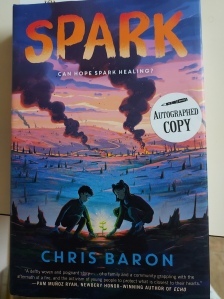Marcia Thornton Jones's Blog, page 2
September 15, 2025
Plot Walks Around the Block
Recently I attended a webinar hosted by Lorin Oberweger andFree Expressions that featured Liz Fenwick (Secret Shore. HarperCollins, 2023). The webinar was part of aseries that focused on writer-oriented discussions. A book club, if you will, inwhich writers take a deep dive into literary crafts elements of a specificbook, and the author of that book discussed her process. Liz Frank introduced anew term, at least for me, in her strategy for dealing with writer’s block.
Plot walks.
Everyone writer understands the dilemma of writer’s block. K.M. Weiland, a speculative writer who also offersexcellent webinars and writes craft books that take very deep dives in thestory engineering process, offers that:
“To be a writer, one must do two things: write and, perhapssurprisingly, not write. Usually we champion the first and demonize the secondwith much fear and trembling, giving it dread labels such as ‘writer’s block.'”
While there are many reasons that can lead to writer’s block,there are two types of block: Life block, in which personal challenges needattending; and plot block, in which the story’s logic has gone amuck. Eitherway, one of the first steps required for sanity’s sake is to step away from thestory. As Weiland suggests, creativity “is your partner, not your servant.” Creativityis not something that can be commanded or demanded. And the return tocreativity tends to happen on its own schedule, not yours.
Which takes us back to plot walks.
Beyond the obvious health benefits, talking a walk – likemeditation –improves your mood, reduces anxiety and encourages creativethinking. Studies show that when the walking allows the mind to relax, it opensup a free flow of ideas. When you concentrate on your plot, like chanting amantra, a-ha moments happen! It’s a meditation of sorts that gives perspective. And perspective is everything, especially as it relates to discovering how to fix the plot’s logic. How characters solve problems. How to find and fight the monsters.
Plot walks. It’s a good thing!
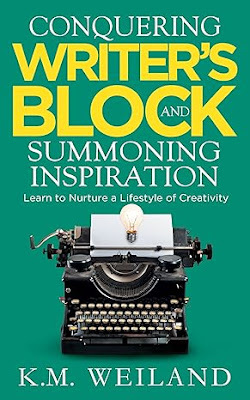 Helping Writers Become Writers Series, Book 7 (2014.
Helping Writers Become Writers Series, Book 7 (2014. Thank you for reading!!
--Bobbi Miller
September 12, 2025
Book Review: SPARK by Chris Baron
It is always a treat to read one of the books written by author Chris Baron. His previous books THE MAGICAL IMPERFECT, THE GREY, set the bar high for verse novels and never shy away from getting to the heart of challenging topics with emotional depth.
His new book SPARK is a welcome addition to his collection.
Here’s the blurb:
As a community recovers from a devastating wildfire, two friends find their way back to each other and their homes, by award-winning author Chris Baron.
Perfect for fans of Alan Gratz and Lauren Tarshis.
Finn and his friend, nicknamed Rabbit, live in a rural area that’s been hit hard by wildfires. Families were displaced and school was interrupted. Moreover, their beloved forest is suffering — animals and plants haven’t been able to come back, and the two friends wonder if there’s anything they can do to help. Rabbit’s uncle, a science teacher, is part of a study that may help bring the forest back to life, but Finn and Rabbit wonder if the forest can wait. And what if another fire comes in the meantime? They believe a small part of the forest — the forest heart — that survived the wildfire may hold the key to regrowth, but first, they have to find it and then convince the adults around them to listen.
For any young person who’s ever felt powerless against the world, here is a story about two kids doing all they can to understand their natural world and preserve it.
★ “This stunning novel in verse shows the impact of climate change and wildfires, and the struggle of living on the border between the forest and urban areas. … Baron balances the emotional weight of trauma by showing characters healing in a variety of ways. Returning wildlife serves as a promise of regrowth and possibility for a different kind of future. Beginning before the fires, continuing through evacuation, and including the season of rebuilding, Spark highlights the impact of wildfires alongside the importance of healing, all while nourishing the brightest spark of all, hope.” ― Booklist, starred review
A lyrical and thoughtful story in verse filled with loss, hope, and recovery. The message that each of us can do something that together can make a difference is the perfect one for today’s world. Inspires and encourages action, and activism in young people as a way to effect change. Highly recommended.
September 11, 2025
What’s a Sweatshirt Doing on a Writing Blog?

This is one of my favorite sweatshirts. And while it’s from the fabulous-to-visit San Francisco, it has nothing to do with the city. It’s here because of the design or, rather, its texture.
If it weren’t for that, this would be a pure vanilla piece of clothing. Both meanings. That’s all well and good, but it’s not interesting.
And now, segueing into writing, vanilla characters hold nothing for me either. Give me personality, even if it’s subtle. And honestly, subtle is often truly interesting. Nuanced characters can hold surprises at every turn. Remember Flat Stanley? Despite his name and his lack of full dimension, Stanley has enough texture to warrant 21 books.
I could go on about how I try to add texture to my own characters, but... Nah! Instead, let me challenge you to pick up any book you love and reread, at least the beginning, to see how the author has added dimension, complexion, complexity – texture – to their characters. Often, the more invisible, the more you’ve fallen in love with them. Like I did with my sweatshirt.
If you happen to be in the Springfield, MO, area, Jody Feldman will be at the Children's Literature Festival of the Ozarks on October 9. If you'd like her to speak to your school or group, she still has availability on 10/8. Contact info on her website.
September 9, 2025
Interview with J.A. Douber, Author of Press 1 for Invasion

Welcome to Smack Dab, J.A.! Please tell us a bit about Press1 for Invasion.
Thank you somuch for having me here! It’s a real pleasure to get a chance to talk about Press1, which is my middle-grade fiction debut; basically, it’s the story of akid who really, really wants a phone, and so when he finds one on the street,he jumps at the chance to use it - but when he looks through the camera, herealizes that his crossing guard is actually a goggle-eyed alien monster thatonly he seems to be able to see. And then he finds out that the guard, alongwith his school’s lunch lady, who’s also an alien, are planning an invasion ofEarth….but the lunch lady’s gotten cold feet (well, cold tentacles), and shedropped the phone for Matt to find. And, along with his friend Marcela, to helpher save the planet. The author’s never the best judge of his own work, butpeople who’ve read it say that it’s fast-paced, and funny, and action-packed.So trust them!
Seriously–humor andaliens? That was all it took for me to know I was all in. What made youdecide to combine such different ideas?
I’m not surethat “decide” is exactly the right word for what I did; the idea and the tonekind of came together all at once. But I was very glad that it worked that way- the central idea, that the fate of the world is on a kid’s shoulders, couldbe really a lot for a character to handle! So making it funny lightens thatload a bit….
So much of sci-fi(time travel, different dimensions, etc.) relies on a portal. Here, you’ve gota found cell phone that allows the main character to connect with aliens. Wheredid that idea come from?
I have threechildren, currently ranging in age from 7 to 12; and though we haven’t had thephone conversation with any of them yet, we’ve certainly had a lot - a lot -of conversations on the subject with other school parents. So I definitely knewfrom that desire for a phone. After I wrote the book, I remembered that E.T.came out when I was about the age of many of Press 1’s reading audience - withthat immortal line “E.T. phone home.” So maybe that was in there somewhere,too! (Although that’s not the way the phone works in the book….)
Matt discoversaliens are a lot closer than he would ever suspect–in fact, it’s serving himlunch! What do you think this says about how we perceive the people aroundus—especially the ones we tend to overlook?
I love this insight!I definitely think that, in general, we tend to see what we expect to see - notbecause we’re bad, or unthoughtful, but just because we’re human. Doctors havethat saying, “When you hear hoofbeats, think horses, not zebras”; in otherwords, it’s probably not some rare mysterious illness when the common cold is apossibility. But in the world of fantasy and adventure, the tables are turned,and the least likely possibility, which is also the most fun, is probably whatit’s going to be….but, of course, that’s exactly what the alien invaders arecounting on!
You’ve writtenacademically. I have to imagine writing MG feels freeing and cathartic…but thenagain, it also could be a struggle to tap into that kind of MG voice. How didyou nail it so perfectly? How do you tap into it?
This is such a nicecompliment! It’s definitely a lot of fun to do; and incredibly useful to talkto my own children, who speak first to sixth grade quite fluently. (Plus I liketalking to them anyway, and I only have to struggle occasionally not to itemizethem as research expenses.)
The story includesa ton of fun scenes: a school cafeteria battle and encounters with alien pets.What was the most fun scene for you to write, and why?
That’s a greatquestion, and I’m not sure I have a great answer, since lots of them were funto write (and it sounds like that sense of fun came across, which iswonderful!). But one of my favorite scenes is the one in which Benedict Arnoldmakes a guest appearance. (If you want to know more about why and how, you’regoing to have to read the book….)
In Press 1 forInvasion, the aliens Matt encounters seem to represent the unknown or theunfamiliar. Was this metaphor intentional, and what do you hope readers takeaway about dealing with things that seem 'alien' in their own lives?
Wow, what a greatobservation! I think the thing that was the most interesting to me about theiralienness - and that became more and more important to me as the book developed- was their lack of individualism. (As you’ll find out when you read it, the aliens,generally, have a kind of collective or “hive” consciousness; something aboutthe Earth’s atmosphere interferes with it, though, which is key to the lunchlady changing her mind about the invasion.) I think that the book - I hope,anyway - makes it clear that something to cherish about us, as human beings,all of us, is our individuality; all of us, every one, are a worldentire.
If you could giveMatt one piece of advice, what would it be?
Never lose sight ofhow special Marcela is.
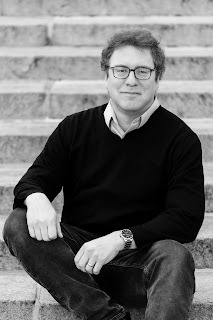
Where can we findyou?
If you have aphone, and that phone has social media apps on it, and you are of an age to usethose apps responsibly, then I’m on Bluesky at @jeremydauber.bsky.social.
What’s next?
I’m working now on atime-travel novel for the same middle grade audience that I think will be a lotof fun….and who knows? Maybe there’ll be some more adventure in store for Mattand Marcela! Thank you so much for this!
Snag a copy of Press 1 for Invasion
September 8, 2025
Happy International Literacy Day!
 To me, the New York Public Library is a temple. Whenever I visit NYC, I pay my respects to this magnificent building. Most of the books live across 5th Avenue or in the neighborhood branches, but I come to marvel at what people built to honor the act of reading.
To me, the New York Public Library is a temple. Whenever I visit NYC, I pay my respects to this magnificent building. Most of the books live across 5th Avenue or in the neighborhood branches, but I come to marvel at what people built to honor the act of reading.Today is International Literacy Day. This year's theme is "Promoting Literacy in the Digital Era."
As readers and writers, we know the statistics about the decline in reading words on a page. From our own experience, we know the difference between entering into a relationship with the text and scrolling. I take it personally whenever I open my manuscript and AI cheerfully offers to summarize all the words I worked so hard to get right. The dangers to my self-expression are nothing compared to what humans will lose if we keep neglecting literacy.
The ceiling on the third floor of the library is covered in murals that depict a history of reading. At the top, we see Prometheus about to give fire to humans. We know from the myths that he will be punished severely for wanting us to have light.
 The other murals depict the history of writing--words carved in stone tablets, copied by hand, set in Gutenberg's press, and eventually the mass production we have today.
The other murals depict the history of writing--words carved in stone tablets, copied by hand, set in Gutenberg's press, and eventually the mass production we have today.
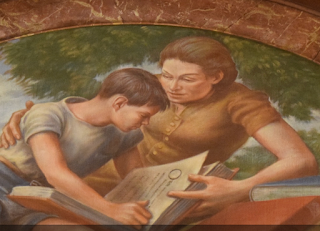 All those advancements culminate in this image--two ordinary people sharing a book.
All those advancements culminate in this image--two ordinary people sharing a book. Let's celebrate that this still happens! Let's dedicate ourselves to making sure the temple to literacy doesn't become a museum to what humans once did before machines took over.
Let's join ILD2025 in "promoting literacy as a common good and a human right--and as a lever for empowerment and transformation to build more inclusive, just and sustainable societies."
JANE KELLEY is a writer, a reader, and a believer in the power of the written word.
September 4, 2025
Interview with Julie A. Swanson, Author of North of Tomboy

We're joined today by Julie Swanson, author of North of Tomboy:
For fans of Kacen Callender, Lin Thompson, and Kyle Lukoff, comes a middle grade novel set in 1973 about a child who feels more boy than girl and is frustrated that people act blind to that when—except for her stupid hair and clothes—it should be obvious!
~
You note this was the firstnovel you ever tried writing and "a hard one at that." What made itso challenging, and why did you keep at it over the years? What drove you tokeep going?
Several things made itchallenging. I wanted this to be for middle grade readers who are the age I waswhen I could've most used this story. And MG books ideally have main characterswho are twelve since kids like to read up (so I've read and been told byeditors and agents), but my main character was nine-and a half. While I waswilling to try to and make her older, this story is semi-autobiographical, and whenI rewrote it that way, it didn't ring true that I would've created Mickey attwelve. Even late-bloomer me who still played other types of pretend games at twelve.I didn't play with dolls at twelve, wasn't being given them for Christmas or mybirthday anymore at that age either. And my creation of Mickey was such aspontaneous, unconscious thing. It wasn't calculated and manipulative (at firstanyway). I didn't know what I was doing; it wasn't premediated. He just bubbledout of me. Kids do things like that--have that innocence and are lessself-conscious about imaginative play--more at 8-9-10 than at 11-12. When Iwrote the story with Jess at 11-12, Mickey felt too contrived. So I knew I hadto make Jess younger than gatekeepers wanted her and that doing so would lessenmy chances of people wanting to publish the story.
Finding the best place to beginwas hard, too. I kept thinking it had to start at Jess's first memory attwo-and-a-half, which made it this epic slice-of-life story that spanned eightyears, another thing gatekeepers didn't like. They said MG stories shouldn'tspan much more than a year's time. ...Once I found where I should begin , itwas like Duh. But fitting in all the backstory that used to be there whenit started with Jess at two-and-a-half, that was difficult, too. I had to learna lot craft-wise to do that.
It was also challenging to cutthe story back to a length gatekeepers wouldn't roll their eyes over. Afterdecades working on it and getting to know it, I felt the story needed to be a longerone, and, on top of that, I tend to over-write, so it was painful to get it toa manageable wordcount. Even once I'd cut all I felt I could, gatekeepers wouldsay it was still too long for MG, which is why I ended up deciding to go with ahybrid publisher. SparkPress was willing to accept it if I got it under 100,000words (it's 92,000). I've been paranoid about its length, about what reviewersand book buyers might say about it, but a few years ago I started compiling alist of MG books I'd read and their lengths, and I saw this trend forincreasingly long MG books. And in the past few months, going into bookstores,I've been surprised to see how thick the books on the MG shelves are! My bookdoesn't look too long at all compared to them. And no one who has reviewed ithas mentioned its length, so phew.
The story has psychologicalaspects to it that made it tricky as well. When I started writing it at twenty-three,I thought I understood what Mickey was, why I created him, why I didn't likebeing a girl, thought I was more boy than girl and would never grow up likegirls do. But I learned so much about myself in my 40s, came to deeper anddeeper levels of understanding. Jess might be an unreliable narrator, but eventhough the story's written in first person present tense, I tried to write it insuch a way that you can read between the lines and see the truth of things thatJess might not be able to yet. I think readers will get things a bit ahead ofJess so they can see where she's mistaken or confused, and why.
The last thing that made thisstory challenging was the portrayal of Mickey: how to convey whether he'stalking or "on" (acting but not talking) or Jess is, how to describehow he sounds and would say things in his weird little way.
Why did I keep going? I wouldask myself that same question when I got discouraged and worried I might neverget it right or that no one would ever want to publish it, that maybe I'd wastedall those years working on it. But I felt driven to keep going. Even when I'dtake breaks from the story to work on a different one, it would nag at me. I'dthink about it, dream about it at night, get ideas, take notes. The storywouldn't leave me alone, and I'd find myself back at it again. I couldn't waitfor whatever other book I was working on to be done, so I could get back to thisstory full-time like I'd promised myself I could after a break from it. I justcouldn't seem to give up on it, even though there were parts of me that feltthat no story means that much in the grand scheme of things.
You mention in your authorbio that you couldn't find books about kids who were "as uncomfortablebeing a girl" as you were. What drove you to finally write that storyyourself?
The word "finally" inthis question doesn't apply, because it wasn't something I put off. I startedwriting this story as soon as I considered myself an adult, which was rightafter I got married, straight out of college. It was a milestone I'd reachedwhere I felt like, Ah, now I can now look back on my childhood and considerit from a more mature perspective and write that story I promised myself Iwould. I couldn't wait to write it! Even as a kid I remember thinking, Whenyou grow up, you have to write about your childhood, how magical it is, howmuch fun you have, about the amazing place we live, our family, Mickey, how itfeels to be this boy/girl person that no one understands. Back then, I sawmy childhood as simply magical, or should I say mostly magical; yes, I spent alot of time being unhappy being a girl, being mad at my mom for making me bethat girl, and we had to walk on eggshells around my dad when he got mad, butother than that, I thought my family and my life were pretty much perfect.Other than that, those little things! Ha, yes, I minimized andcompartmentalized. Anyway, there wasn't anything that "finally" droveme to write it. I couldn't wait to. It was more a matter of how long it took meto get it published, how many versions of it I had to write before then.
The character of Mickey isso vivid and complex. Was there a real Mickey in your life?
Yes, I got a doll for Christmaswhen I was Jess's age, and I cut his hair and turned him into a boy, made himtalk and act things out, just like in North of Tomboy. Unlike Jess, Iasked for the doll for Christmas that year. My mom had a habit of buying me andmy sister dolls, even making us dolls, but I didn't usually like the ones shemade or picked out, so I figured I'd pick one out that had good boy potential (Iliked playing with dolls if they were boys, or action figures). I lookedthrough the Sears Wish Book and JC Penney Christmas catalogue and found a dollwearing a blue sweater set that didn't look too girly, and I put that doll onmy Christmas list. I didn't plan to make him talk, though; that happenedspontaneously just like in the story. In real life, Mickey lasted many years. Icontinued being him, and enjoying being him (unlike Jess, who comes to see himas a habit she needs to break), until an embarrassingly old age.
·
How did you develop Mickey'sdistinctive voice and speech patterns? What was your process for making himfeel like a separate character?
I know it sounds strange to saythis, but I didn't develop Mickey's voice or speech patterns; they just camepouring out of me. And his voice and way of speaking was so different than minethat it surprised me, delighted me. Even once I ditched the doll, as Jess does,and just started "being" and speaking as Mickey all on my own, hestill seemed "not me" like he was some weird little character I waschanneling. And since there was a real Mickey in my life, and for so long (Ican still be him around my mom and sister, but only them. Not when I tryto be him, only when he just spontaneously pipes up, and only once in a while.Weird, I know), I had absolutely no problem hearing his voice in my head while writingthe book. I could imagine the things he'd say and the way he'd say them, evenremember things he actually said.
Conveying that he was aseparate character from Jess was hard. How I did it was something that evolved.I had to figure out ways to cue when Jess was on versus when Mickey was on.Obviously Mickey speaks in such a distinctive way that you'd never mistake hisdialogue for Jess's, but sometimes he's doing things and not speaking--ofcourse really it's Jess doing the things as Mickey--and that could betricky, had to be shown by Jess's body language cuing Mickey, like Jess's upperlip that forms a little beak when he's "on." It's almost like whenpeople have multiple personalities and they switch, have totally differentmannerisms and voices.
How did you balance writingabout serious themes like gender identity and family dynamics while maintainingthe humor and lightness of childhood?
Glad you think I accomplishedthat! As a pretty serious kid (except for Mickey) and someone who tends toanalyze and dwell on heavy things, I worried it might be too much or thatpeople wouldn't think Mickey was as funny as my family did. But I tried to keepit simple and honest (bluntness is often funny, I think), because the feedbackI got on my first versions of this story was that it read like memoir or maybeit should be YA, that it seemed like a lot for middle graders, too deep, withtopics that are a bit mature. Even with a 9/10-year-old main character they'dsay that, which I didn't get, because we all deal with stuff that we're notmature enough for growing up (don't we?), and we have to try to make sense ofit anyway. But I was like, no, I want this to be for middle graders; they'rethe ones who could use this, not people who've already made it through that stage.So I tried to make it younger, simpler, to stay true to Jess's age and how Iwas then. I think the whole spirit of Mickey that infuses the story helps tokeep things light.
How do you think Jess'sstory resonates with contemporary discussions about gender identity andexpression?
It really does resonate. It's verytimely with all that's going on in our world with the controversy of pubertyblockers, parents being accused of child abuse for letting their trans kidsmake certain changes before they're eighteen, gender neutral bathrooms,transgender athletes looking for opportunities to play but people concernedabout the safety and fairness of that... And I think what's interesting about Jess'sstory is that, because of the time period it's set in (early 70s), it's a storythat's stripped of all the labels and terms and lingo that people tend to getcaught up in now, which makes it easier for those uncomfortable with LGBTQtopics to read and take it in, without any jargon turning them off or that'stoo new or hard for them to understand. At least that's what I hope. I hope readerscan just see the humanness and the pain, the distress really, of a child who'sconfused and questioning and uncomfortable in their skin, and that they're notmaking it up--they truly feel that.
What advice would you giveto kids who, like Jess, feel pressure to be someone they're not?
The world--and your gender--isn'tas black-n-white as some people might make it seem it is or should be. Youdon't have to be a girl or a boy, either masculine orfeminine. You can be both at the same time, in some ways masculine and in otherways feminine. Or you can be masculine sometimes, and feminine other times. Youcan also feel like neither. You don't have to find a label for yourself. And ifyou do, or have already, you can change your mind! Things aren't set in stone,fixed and decided for all time. People often change. So be patient, don't rushto a judgement on yourself, feel like you have to decide who or what you are at10 or 11 or 12 or whatever age you might be. And don't let anyone tell you whatyou are, or that who/what you are is wrong. Don't feel you have to be fake tobe "right" (for them). Be right for you, be true to yourself. Be theway that makes you feel good inside. Every morning just wake up and be who youhonestly feel you are that day. If that changes, if you feel differently, ifyou one day know, that's fine. But you don't have to know exactly orhave a word for what you are either. You can just be your own kind of girl orboy, or neither or both, or just your own weird indescribable but loveable you!A person, a human--a brave, growing, living, always changing YOU.
Lastly, if you can find thewords to talk about it, and if you can be brave enough, it always helps to talkabout things with another person, too. Find someone you feel safe with, someoneyou trust. If you're not sure you're brave enough (yet), or you can't find thewords, or you don't know anyone you feel safe enough with, it often helps towrite about it. Sometimes writing/journaling can help you try things out and findthe words to talk about something. Or you can write someone about it instead ofhaving to talk to them about it.
What’s next?
The next book in this series,where Jess is about to turn twelve, at the end of her sixth-grade year!
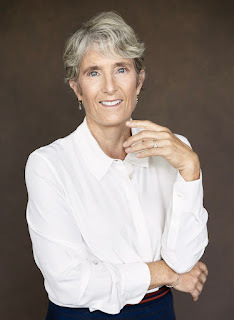
Where can we find you?
At home in Charlottesville,Virginia, or in Maple City, Michigan, or, virtually...
my website, www.julieswanson.com
my blog, https://julieaswanson.wordpress.com/
Snag a copy of North of Tomboy
September 2, 2025
Middle Grade Reading for September
There are so many great new middle grade books out there, and I wanted to highlight three of them. I've interviewed the authors of these books on my blog, Book Q&As with Deborah Kalb, and would like to share some of what they said...
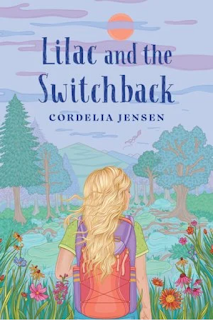
Cordelia Jensen is the author of the new middle grade novel in verse Lilac and the Switchback. She said of her inspiration for the book, "It was actually the setting of Lehigh Universitythat first inspired the story! I love the landscape that surrounds that school.It evokes quintessential Pennsylvania countryside; you can look up to themountains and then down to the river." She added, "Although I personally am more of a 'water person,' when I was on the college tour of the school with my own twins, I pictured a12-year-old girl looking uphill. I knew the girl would help literally blaze atrail while, simultaneously, embarking on an emotional journey to help find herplace in the world."
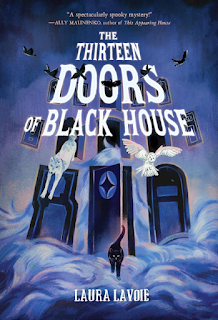 Laura Lavoie is the author of The Thirteen Doors of Black House. She said, "I was inspired to write this book after a summertrip to Maine. A relative we were visiting there mentioned that Stephen King’shouse was a little drive up the coast from where we were staying. My husbandand I are both big fans, so we decided to go check it out." She added, "After we got home from our trip, I wondered, What ifyou could visit your favorite author’s house but actually stay there, like avacation rental? The idea for The Thirteen Doors of Black House was born, andthe rest evolved from there."
Laura Lavoie is the author of The Thirteen Doors of Black House. She said, "I was inspired to write this book after a summertrip to Maine. A relative we were visiting there mentioned that Stephen King’shouse was a little drive up the coast from where we were staying. My husbandand I are both big fans, so we decided to go check it out." She added, "After we got home from our trip, I wondered, What ifyou could visit your favorite author’s house but actually stay there, like avacation rental? The idea for The Thirteen Doors of Black House was born, andthe rest evolved from there."
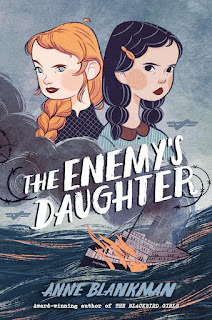 Finally, Anne Blankman's new novel is The Enemy's Daughter. She said, "When I was working as a middle school librarian, Icollaborated with a social studies teacher on a unit about World War I. I wasstanding in the back of the classroom, waiting to help students with research,while the teacher talked about major wartime events, including the bombing ofthe Lusitania. I thought, I wonder what it would have been like to have been apassenger on that ship." She added, "That thought stuck in my mind, and I began playing withideas about a young girl who survives the sinking of the Lusitania—and whofinds herself shipwrecked in an 'enemy' country."
Finally, Anne Blankman's new novel is The Enemy's Daughter. She said, "When I was working as a middle school librarian, Icollaborated with a social studies teacher on a unit about World War I. I wasstanding in the back of the classroom, waiting to help students with research,while the teacher talked about major wartime events, including the bombing ofthe Lusitania. I thought, I wonder what it would have been like to have been apassenger on that ship." She added, "That thought stuck in my mind, and I began playing withideas about a young girl who survives the sinking of the Lusitania—and whofinds herself shipwrecked in an 'enemy' country."--Deborah Kalb
August 30, 2025
Reflections (Holly Schindler)
Reflections is sort of the perfect word to sum up the summer.
I started teaching again this summer. I launched my first video writing course. Really, though, I've been teaching in one way or another for more than 25 years. It started in (ahem) 1999, when I taught my first collegiate writing course. I was a TA at the time, and I wasn't totally clueless about writing by any stretch of the imagination...
But 25 years later, I have soooo much more to say.

My course on chapter breaks meant that suddenly I wanted to talk about how to write scenes, which meant I also wanted to put together a guide on narrative transportation. Not to mention plotting with 5 acts...
You get the idea.
But I can't put together what I've learned without also thinking about where I've been. The cold queries via snail mail and the first call I ever got from an editor and the very first contract I've ever signed. The near misses and the tears and the frustration. The hope and the belief that ran through all of it that I would get there.
Listen: you can too.
It doesn't matter where you are right now. It doesn't matter how bleak it looks or how far you think you have to go. You'll get there.
Part of this renewed love of teaching means that I've also dusted off a long-dormant YouTube channel (I used to post regularly after selling my first books, but then things just kinda...died). And I have a new series called (drumroll) I Have an Idea for a Novel. Now What??? The first vid addresses what makes a good scene (and contains a link to a free download).
See what I mean? Soooo much to say. I hope you'll join me.
~
Holly Schindler is the author of The Junction of Sunshine and Lucky.
August 29, 2025
What Do You See?
by Charlotte Bennardo
Merriam-Webster's Dictionary (https://www.merriam-webster.com/dictionary/reflections) has nine definitions of "reflection." Some are finer points of other definitions, so let's consider these:
1. the return of light or sound waves from a surface
2. the production of an image by or as if by a mirror
3. the action of bending or folding back
4. an obscure or indirect criticism
5. consideration of some subject matter
When applied to writers, authors, and writing, we can use all, if not most of these definitions. A character sees themselves reflected in a mirror or in the appearance of family traits. They also see the reflections of their actions in situations, in their own meditations, or their relationships with others. For us, we may acknowledge that karma is the reflection of our actions upon ourselves. And lastly, our works, our writings, are most likely a reflection of emotions, events, psychologies, thoughts, and actions of our lives through our characters and words.
 Photo by Sindre Fs: https://www.pexels.com/photo/photo-di...
Photo by Sindre Fs: https://www.pexels.com/photo/photo-di...We live like the picture above; in a world which reflects all that we see, feel, learn, suffer, do, and share.
Charlotte writes MG, YA, NA, and adult novels in sci fi, fantasy, contemporary, paranormal and romance genres. Her latest YA fantasy novel, The Excalibur Vow, just released. She is the author of the award-winning middle grade Evolution Revolution trilogy, Simple Machines, Simple Plans, and Simple Lessons. She co-authored the YA novels Blonde OPS, Sirenz, and Sirenz Back in Fashion. She has several short stories in various anthologies. Having finished her MFA, she's applying what she learned and is working on several children's and adult novels, and other short stories. She lives in NJ with her family and floofy cat Mink, a squirrel who insists on digging up her geraniums, and a visiting pet rabbit, Bad Bunny.
August 28, 2025
Interview with James Ponti, Author of Hurricane Heist (The Sherlock Society #2)
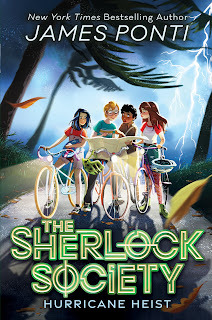
Welcometo Smack Dab, James! Please tell us about Hurricane Heist.
So niceto be here! Hurricane Heist is the second book in the Sherlock Society mysteryseries. The series is about Alex and Zoe Sherlock, a brother and sister who forma detective agency with their grandfather, a retired journalist from the MiamiHerald, and their best friends Yadi and Lina.
In thefirst book, they search for Al Capone’s buried treasure in the Everglades onlyto uncover some environmental wrongdoing that needs immediate attention. Inbook two, they look reopen a cold case from 1964 when a Miami Beach resort wasrobbed during Hurricane Cleo. (The Capone story was real, but I made up theheist in book two.) What’s especially fun about this is there are threechapters set in 1964 and we get to see Grandpa when he was twelve years old.
Eachcharacter has distinct skills. Lina’s the bookworm, Yadi’s the aspiringcinematographer. How did you make sure each team member would have meaningfulcontributions to solving mysteries?
Myfriends and I have a lot in common, but we each have specific passions. Iwanted the same for the kids in these books. For example, I always loved movies,so much so that I majored in filmmaking in college. I gave that to Yadi. I’vemade so many little films that I know what he’s dealing with and theworkarounds that come with trying to make a movie with no money and onlyfriends for a crew.
I cameup with something for each of them, picking the interests first and thenfiguring out how those interests might factor into solving a mystery. Thatapproach seemed more organic than starting with a list of mystery needs andthen reverse engineering interests that went with them.
Howdid you come to choose Miami and South Florida as the setting, and how did youresearch famous people and events like Al Capone and Hurricane Cleo that play arole in the books?
I grewup in a Florida beach town and wanted a book series that reflected my youth.The problem with my hometown, though, is that it’s a little sleepy. That’swonderful for growing up but a little less useful when you’re trying to createmysteries. (I was always confused by that fact that in Murder, She Wrote, CabotCove seemed like the murder capital of the US.) With that in mind, I moved mychildhood the Coconut Grove neighborhood of Miami. The beauty of the city isthat it’s so diverse and a gateway to so many cultures that I have really largepalette to work with.
As forthe research, Miami has such a rich – and at times checkered – history. There’sa great saying about the city that I incorporated into the series, “Miami is asunny place for shady people.” I look to real things that took place there andtry to figure out how those might still come into play. Like in the first book,Al Capone really did bury a treasure that was never found. I think he buriedsafe deposit keys, but I made it money to streamline it a bit.
Thebooks with corporate corruption and environmental themes. How important was itto weave these real-world issues into a middle-grade adventure?
Environmentalismwas always part of my life because I grew up at the beach, where the issue remainsin the forefront. There’s a reason environmental issues play such a big role inbooks by Florida writers like Carl Hiaasen and John D. MacDonald.
Moreimportantly, the environment is a key concern for young people and an arena inwhich they see that they can have an impact. I also think young readers are deeplyconcerned with the concept of fairness and like to see the corrupt get theircomeuppance.
You’vebeen open about hating reading as a kid and being “terribly slow” at it. Didthat help contribute to the development of such a conversational tone? It didsuch a great job of drawing the reader in. It’s almost like listening tosomeone rather than reading!
Ialways struggled with reading as a kid and I try to keep that in mind while Iwrite for young readers. My natural writing style is conversational, which alsomay connect to my background at the beach, where everything is laidback. It’sespecially conversational in this series because it’s narrated by atwelve-year-old boy. Mostly, though, I think my style is the byproduct of yearsand years of working in television on scripts that were centered on dialogue.
Iwas a huge Nancy Drew fan growing up. What do you think makes mystery such aperpetually great middle grade genre?
I thinkthe not-so secret sauces of middle grade mysteries is that they’re sointeractive. More than any other type of a book, a mystery asks the reader tobe a participant. There’s an implicit contract with the readers that I willgive them fair and honest clues so that they can try to solve the puzzlealongside the characters. The trick on my part is that I don’t want them tosolve it before the book reveals the answer. Then I want them to think thatthey should’ve seen it all along.
Thepremise hinges on the idea that having the surname “Sherlock” almost destinesAlex and Zoe to become detectives. Did you always know you wanted to explorethe theme of whether we’re shaped by others’ expectations or whether we canforge our own path? Or did that come about as you were drafting?
I don’tthink I did that intentionally, but it’s a core issue for me, so it may havewell been subliminal. I was born in Italy and never met my father. That’s whereI got Ponti. For years, I went by my step-father’s last name, but he was out ofmy life by the time I was thirteen. I wasn’t his biggest fan and feltencumbered by that name. Legally, my name was still Ponti, so I went back tousing it in the ninth grade. Because my father never came to the states, Ithought the name was pure and had no baggage associated with it in America. Itwas mine and mine alone. I was determined that I was the one who would give itmeaning. That dramatically shaped how I lived my life. However, if my last namewas Sherlock, I would’ve definitely leaned in and become a detective.
Thekids uncover decades-old secrets that implicate powerful people. How do youexplore the theme that seeking truth sometimes comes with real consequences andrisks?
That’sthe core battle they face. I try to mitigate the risks by have the parents andGrandpa thoroughly involved. Ultimately, they are driven by the search fortruth and honesty in pursuit of justice.
TheSherlock Society features a unique three-generation team with Grandpa as bothmentor and active participant. What drew you to exploring how differentgenerations can work together, and what does Grandpa’s journalism backgroundbring to the kids’ detective work?
It wasborn from a very practical need. I wanted the team to travel throughout SouthFlorida, including the Everglades, the Keys, and Miami Beach, which meant Ineeded someone to drive them around. That led me to Grandpa, which led me to questionsabout what type of adult would help these kids. It shaped his personality andtheir relationship, which was also inspired by the fact that my mother livedthe last years of her life in our house and had a very special relationshipwith my sons.
When Icame up with the idea that Grandpa had been an investigative journalist whostill had a storage unit filled with old notes and interviews, I was off to theraces. I really like how young readers have responded to the fact that a73-year-old is a main character in the series. And I love that we get to seehim as a kid in Hurricane Heist.
What’snext for The Sherlock Society?
I’mcurrently writing Sherlock Society 3, in which the team gets caught up in amystery surrounding Miami’s dynamic street art and graffiti community.

Wherecan we find you?
The firststops are jamesponti.com, which is for all of my books, andsherlocksociety.net, which is more Sherlock-specific. I’m on IG(@jamespontibooks) and X (@jamesponti). I’m also doing a book tour and someother public events in the coming months. You can find those details on mywebsites or at linktr.ee/jamespontibooks.
Snag a copy of Hurricane Heist

